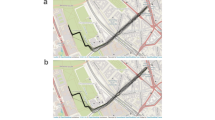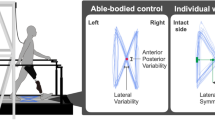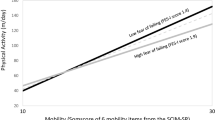Abstract
This study reports the velocity and physiologic cost index (PCI) of ambulation using a functional electrical stimulation (FES) system for ambulation in paraplegic spinal cord injured subjects. Using established techniques, average velocity and heart rate (HR) were measured on five subjects trained with the Parastep® system. PCI was reported for the four subjects who achieved a steady state during ambulation with the Parastep® system. It was found that walking performance varied greatly between subjects, and was correlated to frequency of use of the system. Velocity of walking with the Parastep® system ranged from 4.6 to 24.3m/min. In the four subjects where steady state was achieved, PCI ranged from 2.30 to 6.26 beats/m. The average walking speed and PCI were similar to the values reported using alternative mechanical or hybrid systems available to the spinal cord injured for restoration of upright locomotion.
Similar content being viewed by others
Log in or create a free account to read this content
Gain free access to this article, as well as selected content from this journal and more on nature.com
or
References
Jaeger R J (1992) Lower extremity applications of functional neuromuscular stimulation. Assist Technol 4: 19–30.
Campbell J M, Meadows P M (1992) Therapeutic FES: from rehabilitation to neural prosthetics. Assist Technol 4: 4–18.
Clinkingbeard J R, Gesten J W, Hoehn D (1964) Energy cost of ambulation in traumatic paraplegic. Am J Phys Med 43: 157–165.
Chantraine A, Crielaared J M, Onkelinx A, Pirnay F (1984) Energy expenditure of ambulation in paraplegics: effects of long term use of bracing. Paraplegia 22: 173–181.
Waters R L, Yakura J S, Adkins R, Barnes G (1989) Determinants of gait performance following spinal cord injury. Arch Phys Med Rehabil 70: 811–818.
Douglas R, Larson P F, D'Ambrosia R, McCall R E (1983) The LSU reciprocating gait orthosis. Orthopedics 6: 834–838.
Stallard J, Major R E, Poiner R, Farmer I R, Jones N (1986) Engineering design considerations of the ORLAU ParaWalker and FES hybrid system. Eng Med 15: 123–129.
Hirokawa S, Grimm M, Le T, Solomonow M, Baratta R V, Shoji H, D'Ambrosia R D (1990) Energy comsumption in paraplegic ambulation using the reciprocating gait orthosis and electrical stimulation of the thigh muscles. Arch Phys Med Rehabil 71: 687–694.
Nene A V, Patrick J H (1989) Energy cost of paraplegic locomotion with the ORLAU ParaWalker. Paraplegia 27: 5–18.
Solomonow M, Baratta R, Hirokawa S et al (1989) The RGO generation II muscle stimulation powered orthosis as a practical walking system for thoracic paraplegics. Orthopedics 12: 1309–1315.
McClelland M, Andrews B J, Patrick J H et al (1987) Augmentation of the Oswestry Parawalker orthosis by means of surface electrical stimulation: gait analysis of three patients. Paraplegia 35: 32–38.
Nene A V, Patrick J H (1990) Energy cost of paraplegic locomotion using the ParaWalker—electrical stimulation ‘hybrid’ orthosis. Arch Phys Med Rehabil 71: 116–120.
Miller P, Kobetic R, Lew R (1990) Energy costs of walking and standing using functional electrical stimulation. Proc 13th Association for the Advancement of Rehabilitation and Assistive Technologies Ann Conf Washington: 155–156.
Isakov E, Mizrahi J, Najenson T (1986) Biomechanical and physiological evaluation of FES-activated paraplegic patients. J Rehabil Res Dev 23: 9–19.
Marsolais E B, Kobetic R, Chizeck H J, Jacobs J L (1991) Orthoses and electrical stimulation for walking in complete paraplegia. J Neurol Rehabil 5: 13–22.
Kralj A, Bajd T (1989) Functional Electrical Stimulation: Standing and Walking after Spinal Cord Injury. CRC Press, Boca Raton, FL.
Medical Devices, Diagnostics & Instrumentation Reports—‘The Gray Sheet’ (1993), Vol 18. Chevy Chase, MD: 1–3.
MacGregor J (1979) The objective measurement of physical performance with long-term ambulatory physiological surveillance equipment (LAPSE). Proc 3rd Int Symp on Ambulatory Monitoring, London: 29–39.
Rose J, Gamble J G, Medeiros J M et al (1989) Energy cost of walking in normal children and in those with cerebral palsy: comparison of heart rate and oxygen uptake. J Pediatr Orthop 9: 276–279.
Bowker P, Messenger N, Ogilvie C, Rowley D I (1992) Energetics of paraplegic walking. J Biomed Eng 14: 344–350.
Winchester P K, Carollo J J, Parekh R N et al (1993) A comparison of paraplegic gait performance using two types of reciprocating gait orthoses. Pros 17: 101–106.
Stallard J, Rose G K (1980) Clinical decision making with the aid of ambulatory monitoring of heart rate. Prosthet Orthot Int 4: 91–96.
Isakov E, Douglas R, Berns P (1992) Ambulation using the reciprocating gait orthosis and functional electrical stimulation. Paraplegia 30: 239–245.
Bar-On Z H, Nene A V (1990) Relationship between heart rate and oxygen uptake in thoracic level paraplegics. Paraplegia 28: 87–95.
Perry J (1992) Stride Analysis. In: Gait Analysis Normal and Pathological Function. Slack Inc, Thorofare, NJ.
Hamzeh M, Bowker P, Rowley D (1988) Below-knee cast design and the energy cost of ambulation. Clin Biomech 3: 74–78.
Author information
Authors and Affiliations
Rights and permissions
About this article
Cite this article
Winchester, P., Carollo, J. & Habasevich, R. Physiologic costs of reciprocal gait in FES assisted walking. Spinal Cord 32, 680–686 (1994). https://doi.org/10.1038/sc.1994.110
Issue date:
DOI: https://doi.org/10.1038/sc.1994.110
Keywords
This article is cited by
-
Functional walking ability of paraplegic patients: comparison of functional electrical stimulation versus mechanical orthoses
European Journal of Orthopaedic Surgery & Traumatology (2013)
-
Energy consumption of paraplegic locomotion using reciprocating gait orthosis
European Journal of Applied Physiology and Occupational Physiology (1996)



